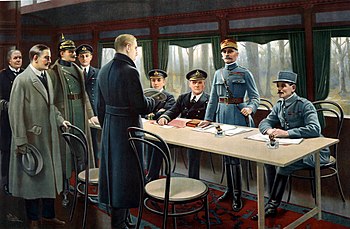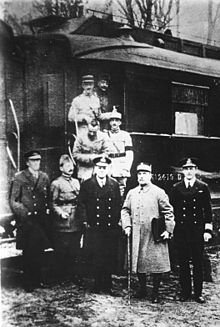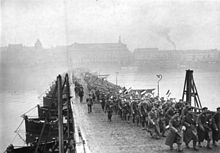Armistice of Compiegne (1918)

The first armistice of Compiègne ( French Armistice de Rethondes ) was concluded on November 11, 1918 between the German Reich and the two western powers France and Great Britain and ended the fighting in the First World War .
The contract was signed in a railway saloon car that stood in a clearing near Rethondes east of the northern French city of Compiègne .
Political framework
With the failure of the spring offensives of 1918 , the German Supreme Army Command (OHL) realized that the war could no longer be won militarily. Since the summer there have even been signs of defeat. The situation on the Western Front had become more and more hopeless as a result of the increased intervention of American troops . The Allies' final offensive began on August 8, 1918 . The collapse of Bulgaria in mid-September prompted the German high command to take further steps in the face of an imminent catastrophe. The German military leadership feared the collapse of the western front and the advance of enemy troops into Reich territory.
On September 29, 1918, Erich Ludendorff, on behalf of the OHL, called on the Reich government to begin negotiations on an armistice with US President Woodrow Wilson , whose 14-point program from January 1918 had the best prospect of a mutual agreement under relatively favorable circumstances promised. For this purpose, the democratic opposition of the Social Democrats , the Center and the Progress Party was integrated into the new Reich government under Prince Max von Baden as part of the October reform .
Negotiation process
An appointment for a meeting was only made after a week-long exchange of notes with the American Secretary of State Robert Lansing . After a month's delay, a German delegation headed by State Secretary Matthias Erzberger received permission to travel to France. The French selected a railway wagon in a wooded area in the municipality of Compiègne near the small town of Rethondes, where the Allied High Command had been located until March 1918. Erzberger, who was called to the delegation in Berlin at noon on November 6th, was appointed head of the delegation in Spa immediately before leaving there on November 7th. In the evening the delegation crossed the front line near La Capelle ( ⊙ ) and reached the clearing of Rethondes on November 8, 1918 . The first discussions took place that day at 10 a.m.
The Allied Commander-in-Chief Marshal Foch, however, remained very limited in the scope of the negotiations . The German representatives were given a tight time frame of 72 hours and were only allowed to dialogue with lower-ranking officers. The French generalissimo reserved the right to humiliate the enemy by being absent.
The Germans found the terms of the armistice proposed to them to be very harsh, but the delegation of the Entente Powers did not accept any objections. Erzberger sought consultation in Berlin and was allegedly instructed by Chancellor Friedrich Ebert, after consultation with the head of the OHL, Hindenburg , to accept the armistice under any conditions. In fact, the telegram in question came from the OHL without consulting Ebert, who only subsequently agreed. Nonetheless, these events contributed to the legend of the stab in the back.
The contract was signed on November 11 between 5:12 am and 5:20 am French time.
Relevant points of the contract
- Cessation of hostilities within six hours of the signature of the contract
- Withdrawal of all German troops from all occupied territories in Belgium , France , Luxembourg and the realm of Alsace-Lorraine within 15 days
- Within the following 17 days
- Occupation of the areas on the left bank of the Rhine and of the bridgeheads around Mainz , Koblenz and Cologne on the right bank of the Rhine by French troops
- Handover of 5,000 cannons, 25,000 machine guns, 3,000 mortars and 1,700 aircraft to the Entente
- Internment of all modern ships of the Imperial Navy
- the British naval blockade was not lifted
- Delivery of 5,000 locomotives and 150,000 railway wagons
- Annulment of the Brest-Litovsk peace with Soviet Russia
- Withdrawal of German troops from the German East Africa colony
These measures prevented the German Reich from continuing the war. Foch said that Germany was now "at the mercy of the victors at mercy and disgrace".
The repatriation of around 190 divisions of the German Western Army agreed in the armistice was ended by January 17, 1919.
Signatory
Entente:
- Marshal Ferdinand Foch for France, Generalissimo of the Allied Forces on the Western Front
- Admiral Sir Rosslyn Wemyss , First Sea Lord
and Admiral George Hope (1869-1959) and Sea Captain Jack Marriott (1879-1938) for Great Britain
German Empire:
- State Secretary Matthias Erzberger , Reich Government
- Count Alfred von Oberndorff , Foreign Office
- General Detlof von Winterfeldt , German Imperial Army
- Captain Ernst Vanselow, Imperial Navy
Extensions and further development

The armistice came into effect on November 11th at 11 a.m. French time (12 p.m. German time) and was supposed to last for 36 days, but was extended on December 12, 1918. It was extended three times in total, with the first two extensions specifying both the period of "one month" and a specific expiry date:
- December 13, 1918 in Trier : until January 17, 1919;
- January 16, 1919 in Trier: until February 17, 1919;
- February 16, 1919 in Trier: for a “short period”, but without a specific expiry date (with a notice period of three days by the Allies).
Only the Treaty of Versailles , signed on June 28, 1919 and entered into force on January 10, 1920 , formally ended the state of war .
See also
literature
- Henning Köhler : November Revolution and France. The French policy towards Germany 1918–1919. Droste, Düsseldorf 1980, ISBN 3-7700-0558-9 .
- Eberhard Kolb : The Peace of Versailles (= Beck'sche series. 2375). CH Beck, Munich 2005, ISBN 3-406-50875-8 .
- Gerd Krumeich : Revolution and Armistice 1918 , in: Ute Daniel / Henning Steinführer (ed.): The November Revolution in Context - Brunswick and German History 1916 to 1923 , Wendeburg (Verlag Uwe Krebs) 2020, pp. 63–72. ISBN 978-3-932030-88-8
- Edmund Marhefka (ed.): The armistice 1918-1919. The documents relating to the armistice negotiations in Compiègne, Spa, Trier and Brussels. Exchange of notes, minutes of negotiations, contracts, overall activity report. 3 volumes. German Publishing Society for Politics and History, Berlin 1928.
- Volume 1: The Compiègne Armistice Agreement and its extensions together with the financial provisions.
- Volume 2: The implementation negotiations and agreements for the armistice treaties.
- Volume 3: The German Armistice Commission. Report on their activities from the conclusion of the armistice to the entry into force of the peace, presented to the German Reich in January 1920.
- Klaus Schwabe : German Revolution and Wilson Peace. The American and German peace strategy between ideology and power politics 1918/19. Droste, Düsseldorf 1971, ISBN 3-7700-0219-9 (Freiburg (Breisgau), University, habilitation paper, 1969).
- David Stevenson: French War Aims against Germany. 1914-1919. Clarendon Press, Oxford 1982, ISBN 0-19-822574-1 .
Web links
- The final armistice terms set by Marshal Foch (PDF) . From: German History in Documents and Pictures , Vol. 6: The Weimar Republic 1918 / 19–1933 , accessed on May 7, 2019; Source: The Armistice 1918-1919. The documentary material of the armistice negotiations in Compiègne, Spa, and Brussels . German Publishing Society for Politics and History, Berlin 1928, pp. 23–57.
Individual evidence
- ↑ Eberhard Kolb : The Peace of Versailles . Beck, Munich 2005, 2nd edition 2011, ISBN 3-406-50875-8 , p. 37.
- ^ Raymond Poidevin , Jacques Bariéty: France and Germany. The history of their relationships 1815–1975. CH Beck, Munich 1982, ISBN 3-406-04124-8 , p. 298.
- ^ Convention d'armistice. In: Digital Library of the University of Perpignan. Retrieved November 13, 2014 (French).
Coordinates: 49 ° 25 ′ 38.5 " N , 2 ° 54 ′ 23.1" E



